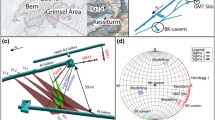Abstract
Petrophysical measurements were carried out on dry specimens of mica-gneiss, amphibolite and serpentinite from KTB core samples and samples of surface outcrops in order to determine the effect that a deviatoric stress field, as observed at the KTB area, may have on the in-situ rock properties. Simulating the variation of the actual principal stresses and temperature with depth, seismic wave velocities, densities, linear and volumetric strain (porosity) have been measured, taking into account the overall spatial orientation of the foliation at the KTB area with respect to the principal stress axes. Comparison with respective data evaluated for lithostatic pressure conditions revealed that the stress-related (crack-related) effect on wave velocities respectively on velocity anisotropy is in the range 1–3%, due to microcracks which are selectively closed or kept open by the deviatoric stress. The effect of the deviatoric stress is particularly documented by shear wave splitting due to microfractures that are oriented normal to the minimum principal stress axis.
Similar content being viewed by others
References
Baumgärtner, J. Rummel, F. and Zoback, M.D.: 1990, ‘Hydraulic Fracturing In-situ Stress Measurements to 3 km Depth in the KTB Pilot Hole VB: A Summary of a Preliminary Data Evaluation’,KTB-Report 90-6a, 353–400, NLfB, Hannover, Germany.
Burkhardt, M., Erbas, K., Giese, P. Haack, U., Hornamand, H., Huenges, E., Stiefel, A., Wilhelm, H., Zoth, G., Buntebarth, G., Schulz, R.: 1989, ‘Das vorhergesagte und das gemessene Temperaturprofil’, in: Emmermann und Giese (eds.),KTB-REPORT 89-3, 216–242.
Christensen, N.I., 1965: ‘Compressional Wave Velocities in Metamorphic Rocks to 10 kbar’,J.Geophys. Res. 70, 6147–6164.
Christensen, N.I. and Crosson, R.S.: 1968, ‘Seismic Anisotropy in the Upper Mantle’,Tectonophysics 6, 93–107.
Crampin, S.: 1987, ‘The Geological and Industrial Implications of Extensive-Dilatancy Anisotropy’,Nature 328, 491–496.
Crosson, R.S. and Lin, J.W.: 1971, ‘Voigt and Reuss Prediction of Anisotropic Elasticity of Dunite’,J. Geophys. Res. 76, 570–578.
Emmermann, R. and Rischmüller, H.: 1990, ‘Das Kontinentale Tiefbohrprogramm der Bundesrepublik Deutschland (KTB)’,Geowissenschaften 9, 241–257.
Kern, H.: 1982, ‘P- and S-wave Velocities in Crustal and Mantle Rocks under the Simultaneous Action of High Confining Pressure and High Temperature and the Effect of the Rock Microstructure’, in: W. Schreyer (ed.).High Pressure Researches in Geoscience, Schweizerbart, Stuttgart, pp 15–45.
Kern H. and Schmidt, R.: 1990, ‘Physical Properties of KTB Core Samples at Simulated In-situ Conditions’,Scientific Drilling. 1, 217–223.
Kern, H. and Wenk, H.-R.: 1990, ‘Fabric-Related Velocity Anisotropy and Shear Wave Splitting in Rocks from the Santa Rosa Mylonite Zone, California’,J. Geophys. Res. 95, 11.213–11.223.
Kern H., Schmidt, R. and Popp, T.: 1991, ‘The Velocity and Density Structure of the 4000m Crustal Segment at the KTB Drilling Site and their Relationship to Lithiological and Microstructural Characteristics of the Rocks: an Experimental Approach’,Scientific Drilling 2, 130–145.
Mainprice, D.: 1990, ‘A FORTRAN Program to Calculate Seismic Anisotropy from the Lattice Preferred Orientation of Minerals’,Computer and Geosciences 16, 385–393.
Mastin, L., Heinemann, B., Krammer, A. Fuchs, K. and Zoback, M.D.: 1990, ‘Stress Orientation in the KTB Pilot Hole Determined from Stress-Induced Wellbore Breakouts’, in: Emmermann and Giese (eds.), Beiträge zum 3. KTB-Kolloquium,KTB-Repoert 90-4, NLfB, Hannover.
Peselnick, L., Nicolas, A. and Stevensen, P.R.: 1974, ‘Velocity Anisotropy in a Mantle Peridotite from the Ivrea Zone: Application to Upper Mantle Anisotropy’,J. Geophys. Res. 79, 1175–1182.
Popp, T. and Kern, H.: this issue, ‘The Influence of Dry and Water Saturated Cracks on Seismic Velocities of Crustal Rocks’,Surveys in Geophysics.
Vernik, L. and Nur, A.: 1992, ‘Petrophysical Analysis of the Cajon Pass Scientific Well: Implications for Fluid Flow and Seismic Studies in the Continental Crust’,J. Geophys. Res. 97, 5121–5134.
Zang, A., Berckhemer, H. and Wolter, K.E.: 1990, ‘Inferring the In-situ State of Stress from Stress Relief Microcracking in Drill Holes’,KTB-Report 90-8, F1–F20, NLfB Hannover.
Author information
Authors and Affiliations
Rights and permissions
About this article
Cite this article
Kern, H., Popp, T. & Schmidt, R. The effect of a deviatoric stress on physical rock properties. Surv Geophys 15, 467–479 (1994). https://doi.org/10.1007/BF00690170
Received:
Issue Date:
DOI: https://doi.org/10.1007/BF00690170




